Optimizing Multi-Microgrid Operations with Battery Energy Storage and Electric Vehicle Integration: A Comparative Analysis of Strategies
Abstract
1. Introduction
1.1. Background and Motivation
1.2. Literature Review
1.3. Research Gap and Contributions
- Development of mathematical models for each operational strategy:
- (a)
- IO model: Each MG optimizes its operations independently, without power sharing or data exchange with other MGs.
- (b)
- CBO model with power sharing: This model optimizes the collective operations of MMGs to enhance overall efficiency through coordinated power sharing.
- (c)
- Cooperative model using GT and the ADMM: This approach combines cooperative GT to ensure fair profit allocation among MMGs with ADMM to enhance computational efficiency. It facilitates power sharing while preserving a degree of autonomy for each MG within the MMG system.
- Statistical modeling of EVs in the MMG system: The model incorporates both V2L and V2G functions, ensuring practical evaluations.
- Annual simulations for the MMG system: Simulations are conducted to account for seasonal variations, including typical EV usage patterns, load data, time-of-use (TOU) tariffs, and RE generation profiles.
- Annual cost analysis: The yearly electricity costs for each MG within the MMG system are calculated for all operational strategies to evaluate their economic performance.
2. Comparative Analysis Framework
2.1. System Configuration
2.2. Selection and Implementation of Operational Strategies
2.3. Individual Operation
2.3.1. Objective Function
2.3.2. Constraints
2.4. Community-Based Operation
2.4.1. Objective Function
2.4.2. Constraints
2.5. Cooperative Game-Theoretic Method
2.5.1. Objective and Cost Allocation
2.5.2. Adjustment of Cost Shares
| Algorithm 1: Shapley Value Calculation for MGs |
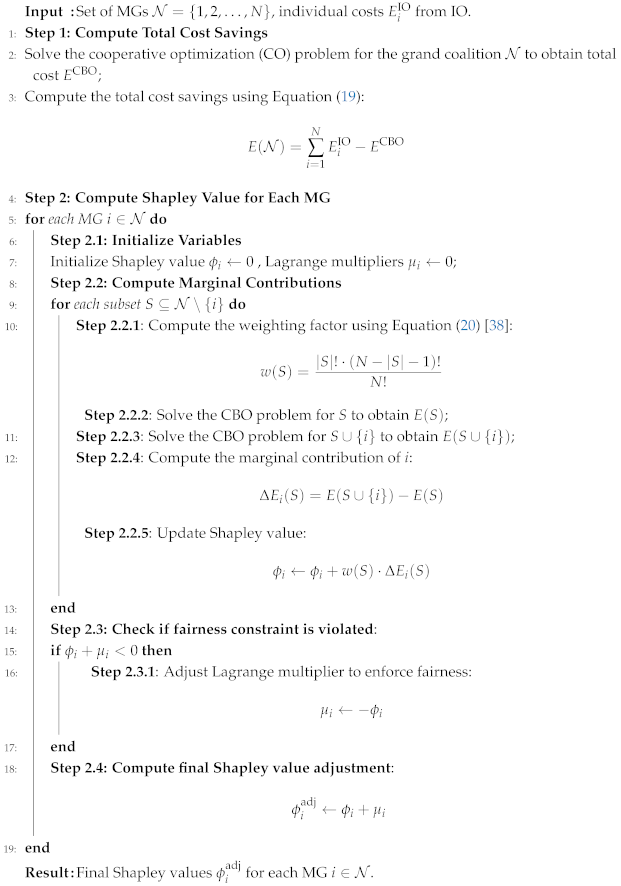 |
2.6. Alternating Direction Method of Multipliers (ADMM)
2.6.1. Local Optimization Problem
2.6.2. Global Consensus and Dual Variable Updates
| Algorithm 2: Alternating direction method of multipliers (ADMM) for power sharing within the MMG system |
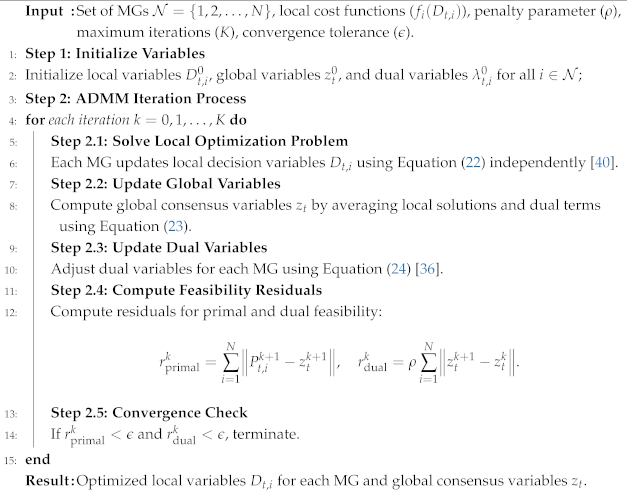 |
3. Simulation Setup
3.1. Input Data
- MG1 has EVs with battery capacities of 37.9 kWh and 39.2 kWh with initial an state-of-charge (SOC) of 34% and 25%, respectively.
- MG2 includes EVs with battery capacities of 38.3 kWh and 64 kWh with an initial SOC of 24% and 33.5%, respectively.
- MG3 includes EVs with battery capacities of 51 kWh and 76 kWh with an initial SOC of 36% and 34.5%, respectively.
- Peak hours: 6:00 P.M. to 9:00 P.M.,
- Off-peak hours: 6:00 A.M. to 6:00 P.M. and 9:00 P.M. to 12:00 A.M.,
- Super off-peak hours: 12:00 A.M. to 6:00 A.M.
3.2. Performance Evaluation
3.2.1. Individual Operation
3.2.2. Community-Based Operation and Cooperative Game-Theoretic Method
3.2.3. Alternating Direction Method of Multipliers (ADMM)
4. Results and Analysis
4.1. Seasonal Analysis
4.1.1. Individual Operation
4.1.2. Community-Based Operation and Game-Theoretic Method
4.1.3. Alternating Direction Method of Multipliers (ADMM)
4.2. Annual Cost Analysis
5. Discussion
6. Conclusions and Future Work
Author Contributions
Funding
Data Availability Statement
Conflicts of Interest
Abbreviations
| ADMM | Alternating Direction Method of Multipliers |
| BESS | Battery Energy Storage System |
| CBO | Community-Based Operation |
| EV | Electric Vehicle |
| GT | Game-Theoretic |
| IO | Individual Operation |
| MAS | Multi-Agent System |
| MG | Microgrid |
| MMG | Multi-Microgrid |
| MO | Market Operator |
| NREL | National Renewable Energy Laboratory |
| NSERC | Natural Sciences and Engineering Research Council |
| OEDI | Open Energy Data Initiative |
| PV | Photovoltaic |
| RE | Renewable Energy |
| SOC | State-of-Charge |
| TOU | Time-of-Use |
| V2G | Vehicle-to-Grid |
| V2L | Vehicle-to-Load |
| VESS | Virtual Energy Storage Systems |
References
- Zou, H.; Mao, S.; Wang, Y.; Zhang, F.; Chen, X.; Cheng, L. A survey of energy management in interconnected multi-microgrids. IEEE Access 2019, 7, 72158–72169. [Google Scholar] [CrossRef]
- Rehman, M.A.; Numan, M.; Tahir, H.; Rahman, U.; Khan, M.W.; Iftikhar, M.Z. A comprehensive overview of vehicle to everything (V2X) technology for sustainable EV adoption. J. Energy Storage 2023, 74, 109304. [Google Scholar] [CrossRef]
- Mojumder, M.R.H.; Ahmed Antara, F.; Hasanuzzaman, M.; Alamri, B.; Alsharef, M. Electric vehicle-to-grid (V2G) technologies: Impact on the power grid and battery. Sustainability 2022, 14, 13856. [Google Scholar] [CrossRef]
- Xing, X.; Jia, L. Energy management in microgrid and multi-microgrid. IET Renew. Power Gener. 2023, 18, 3480–3508. [Google Scholar] [CrossRef]
- Tan, B.; Chen, S.; Liang, Z.; Zheng, X.; Zhu, Y.; Chen, H. An iteration-free hierarchical method for the energy management of multiple-microgrid systems with renewable energy sources and electric vehicles. Appl. Energy 2024, 356, 122380. [Google Scholar]
- Nawaz, A.; Zhou, M.; Wu, J.; Long, C. A comprehensive review on energy management, demand response, and coordination schemes utilization in multi-microgrids network. Appl. Energy 2022, 323, 119596. [Google Scholar]
- Mansour-Saatloo, A.; Pezhmani, Y.; Mirzaei, M.A.; Mohammadi-Ivatloo, B.; Zare, K.; Marzband, M.; Anvari-Moghaddam, A. Robust decentralized optimization of Multi-Microgrids integrated with Power-to-X technologies. Appl. Energy 2021, 304, 117635. [Google Scholar]
- Masrur, H.; Shafie-Khah, M.; Hossain, M.J.; Senjyu, T. Multi-energy microgrids incorporating EV integration: Optimal design and resilient operation. IEEE Trans. Smart Grid 2022, 13, 3508–3518. [Google Scholar]
- Billah, M.; Yousif, M.; Numan, M.; Salam, I.U.; Kazmi, S.A.A.; Alghamdi, T.A. Decentralized smart energy management in hybrid microgrids: Evaluating operational modes, resources optimization, and environmental impacts. IEEE Access 2023, 11, 143530–143548. [Google Scholar]
- Shamshirband, M.; Salehi, J.; Gazijahani, F.S. Decentralized trading of plug-in electric vehicle aggregation agents for optimal energy management of smart renewable penetrated microgrids with the aim of CO2 emission reduction. J. Clean. Prod. 2018, 200, 622–640. [Google Scholar] [CrossRef]
- Shahgholian, G. A brief review on microgrids: Operation, applications, modeling, and control. Int. Trans. Electr. Energy Syst. 2021, 31, e12885. [Google Scholar]
- Liu, C.; Li, Z. Comparison of centralized and peer-to-peer decentralized market designs for community markets. IEEE Trans. Ind. Appl. 2021, 58, 67–77. [Google Scholar] [CrossRef]
- Nikkhah, S.; Allahham, A.; Royapoor, M.; Bialek, J.W.; Giaouris, D. A community-based building-to-building strategy for multi-objective energy management of residential microgrids. In Proceedings of the 2021 12th International Renewable Engineering Conference (IREC), Amman, Jordan, 14–15 April 2021; IEEE: Piscataway, NJ, USA, 2021; pp. 1–6. [Google Scholar]
- Malik, M.M.; Kazmi, S.A.A.; Asim, H.W.; Ahmed, A.B.; Shin, D.R. An intelligent multi-stage optimization approach for community based micro-grid within multi-microgrid paradigm. IEEE Access 2020, 8, 177228–177244. [Google Scholar]
- Li, J.; Liu, Y.; Wu, L. Optimal operation for community-based multi-party microgrid in grid-connected and islanded modes. IEEE Trans. Smart Grid 2016, 9, 756–765. [Google Scholar] [CrossRef]
- Olivares, D.E.; Cañizares, C.A.; Kazerani, M. A centralized energy management system for isolated microgrids. IEEE Trans. Smart Grid 2014, 5, 1864–1875. [Google Scholar] [CrossRef]
- Javadi, M.; Marzband, M.; Funsho Akorede, M.; Godina, R.; Saad Al-Sumaiti, A.; Pouresmaeil, E. A centralized smart decision-making hierarchical interactive architecture for multiple home microgrids in retail electricity market. Energies 2018, 11, 3144. [Google Scholar] [CrossRef]
- Ahsan, S.M.; Iqbal, M.A.; Hussain, A.; Musilek, P. Adaptive Pricing-Based Optimized Resource Utilization in Networked Microgrids. IEEE Access 2025, 13, 34483–34495. [Google Scholar] [CrossRef]
- Ahsan, S.M.; Khan, H.A.; Hassan, N.U.; Arif, S.M.; Lie, T.T. Optimized power dispatch for solar photovoltaic-storage system with multiple buildings in bilateral contracts. Appl. Energy 2020, 273, 115253. [Google Scholar]
- Ahsan, S.M.; Khan, H.A.; Naveed-ul-Hassan. Optimized power dispatch for smart building (s) and electric vehicles with V2X operation. Energy Rep. 2022, 8, 10849–10867. [Google Scholar]
- Ahsan, S.M.; Khan, H.A.; Sohaib, S.; Hashmi, A.M. Optimized Power Dispatch for Smart Building and Electric Vehicles with V2V, V2B and V2G Operations. Energies 2023, 16, 4884. [Google Scholar] [CrossRef]
- Kumar, A.; Jain, P.; Sharma, S. Transactive energy management for microgrids considering techno-economic perspectives of utility—A review. Int. J. Energy Res. 2022, 46, 16127–16149. [Google Scholar]
- Barani, M.; Vadlamudi, V.V.; Farzin, H. Impact of cyber failures on operation and adequacy of Multi-Microgrid distribution systems. Appl. Energy 2023, 348, 121437. [Google Scholar] [CrossRef]
- Saha, D.; Bazmohammadi, N.; Vasquez, J.C.; Guerrero, J.M. Multiple microgrids: A review of architectures and operation and control strategies. Energies 2023, 16, 600. [Google Scholar] [CrossRef]
- Prete, C.L.; Hobbs, B.F. A cooperative game theoretic analysis of incentives for microgrids in regulated electricity markets. Appl. Energy 2016, 169, 524–541. [Google Scholar]
- Karimi, H.; Jadid, S. Modeling of transactive energy in multi-microgrid systems by hybrid of competitive-cooperative games. Electr. Power Syst. Res. 2021, 201, 107546. [Google Scholar]
- Li, C.; Kang, Z.; Yu, H.; Wang, H.; Li, K. Research on Energy Optimization Method of Multi-microgrid System Based on the Cooperative Game Theory. J. Electr. Eng. Technol. 2024, 19, 2953–2962. [Google Scholar]
- Chen, W.; Wang, J.; Yu, G.; Chen, J.; Hu, Y. Research on day-ahead transactions between multi-microgrid based on cooperative game model. Appl. Energy 2022, 316, 119106. [Google Scholar]
- Modarresi, J. Coalitional game theory approach for multi-microgrid energy systems considering service charge and power losses. Sustain. Energy Grids Netw. 2022, 31, 100720. [Google Scholar]
- Movahednia, M.; Karimi, H.; Jadid, S. A cooperative game approach for energy management of interconnected microgrids. Electr. Power Syst. Res. 2022, 213, 108772. [Google Scholar]
- Islam, M.M.; Yu, T.; La Scala, M.; Wang, J.; Chengdong, L. Optimizing Cooperative Alliance Transactive Energy Framework for PV-based Multi-Microgrids Using Scheduling and Cooperative Game Theory. In Proceedings of the 2024 4th International Conference on Electrical Engineering and Informatics (ICon EEI), Pekanbaru, Indonesia, 16–17 October 2024; IEEE: Piscataway, NJ, USA, 2024; pp. 96–101. [Google Scholar]
- Zhong, X.; Zhong, W.; Liu, Y.; Yang, C.; Xie, S. Coalition game approach for electricity sharing in multi-energy multi-microgrid network. In Proceedings of the 2021 IEEE International Smart Cities Conference (ISC2), Virtual, 7–10 September 2021; IEEE: Piscataway, NJ, USA, 2021; pp. 1–6. [Google Scholar]
- Gao, H.; Liu, J.; Wang, L.; Wei, Z. Decentralized energy management for networked microgrids in future distribution systems. IEEE Trans. Power Syst. 2017, 33, 3599–3610. [Google Scholar]
- Liu, G.; Ollis, T.B.; Ferrari, M.F.; Sundararajan, A.; Chen, Y. Distributed Energy Management for Networked Microgrids Embedded Modern Distribution System Using ADMM Algorithm. IEEE Access 2023, 11, 102589–102604. [Google Scholar] [CrossRef]
- Mansouri, S.A.; Nematbakhsh, E.; Ramos, A.; Tostado-Véliz, M.; Aguado, J.A.; Aghaei, J. A Robust ADMM-Enabled Optimization Framework for Decentralized Coordination of Microgrids. IEEE Trans. Ind. Inform. 2024, 21, 1479–1488. [Google Scholar] [CrossRef]
- Rajaei, A.; Fattaheian-Dehkordi, S.; Fotuhi-Firuzabad, M.; Moeini-Aghtaie, M. Decentralized transactive energy management of multi-microgrid distribution systems based on ADMM. Int. J. Electr. Power Energy Syst. 2021, 132, 107126. [Google Scholar] [CrossRef]
- Li, Q.; Ge, Z.; Zhang, R.; Wang, C.; Zhang, Y. Research on the Economic Scheduling of Multi-Distributed Power Sources Based on the Super-Node Cooperative ADMM Algorithm. In Artificial Intelligence Technologies and Applications; IOS Press: Amsterdam, The Netherlands, 2024; pp. 629–636. [Google Scholar]
- Suh, J.; Yoon, S.G. Profit-sharing rule for networked microgrids based on Myerson value in cooperative game. IEEE Access 2020, 9, 5585–5597. [Google Scholar] [CrossRef]
- Sanjab, A.; Le Cadre, H.; Mou, Y. TSO-DSOs stable cost allocation for the joint procurement of flexibility: A cooperative game approach. IEEE Trans. Smart Grid 2022, 13, 4449–4464. [Google Scholar] [CrossRef]
- Zhao, D.; Zhang, C.; Cao, X.; Peng, C.; Sun, B.; Li, K.; Li, Y. Differential privacy energy management for islanded microgrids with distributed consensus-based ADMM algorithm. IEEE Trans. Control Syst. Technol. 2022, 31, 1018–1031. [Google Scholar] [CrossRef]
- National Renewable Energy Laboratory (NREL). Open Energy Data Initiative (OEDI). Available online: https://data.openei.org/ (accessed on 1 September 2023).
- Duke Energy. Time-of-Use Rate. Available online: https://www.duke-energy.com/home/billing/time-of-use (accessed on 1 November 2024).
- National Renewable Energy Laboratory (NREL). PVWatts® Calculator. Available online: https://pvwatts.nrel.gov/ (accessed on 1 November 2024).
- Hussain, A.; Musilek, P. Reliability-as-a-Service usage of electric vehicles: Suitability analysis for different types of buildings. Energies 2022, 15, 665. [Google Scholar] [CrossRef]
- Khan, S.; Alam, M.S.; Asghar, M.J.; Khan, M.A.; Abbas, A. Recent development in level 2 charging system for xEV: A review. In Proceedings of the 2018 International Conference on Computational and Characterization Techniques in Engineering & Sciences (CCTES), Lucknow, India, 14–15 September 2018; IEEE: Piscataway, NJ, USA, 2018; pp. 83–88. [Google Scholar]
- Ahsan, S.M.; Khan, H.A. Performance comparison of CdTe thin film modules with c-Si modules under low irradiance. IET Renew. Power Gener. 2019, 13, 1920–1926. [Google Scholar] [CrossRef]
- Javanmard, B.; Tabrizian, M.; Ansarian, M.; Ahmarinejad, A. Energy management of multi-microgrids based on game theory approach in the presence of demand response programs, energy storage systems and renewable energy resources. J. Energy Storage 2021, 42, 102971. [Google Scholar] [CrossRef]
- Aitzhan, N.Z.; Svetinovic, D. Security and Privacy in Decentralized Energy Trading Through Multi-Signatures, Blockchain and Anonymous Messaging Streams. IEEE Trans. Dependable Secur. Comput. 2018, 15, 840–852. [Google Scholar] [CrossRef]


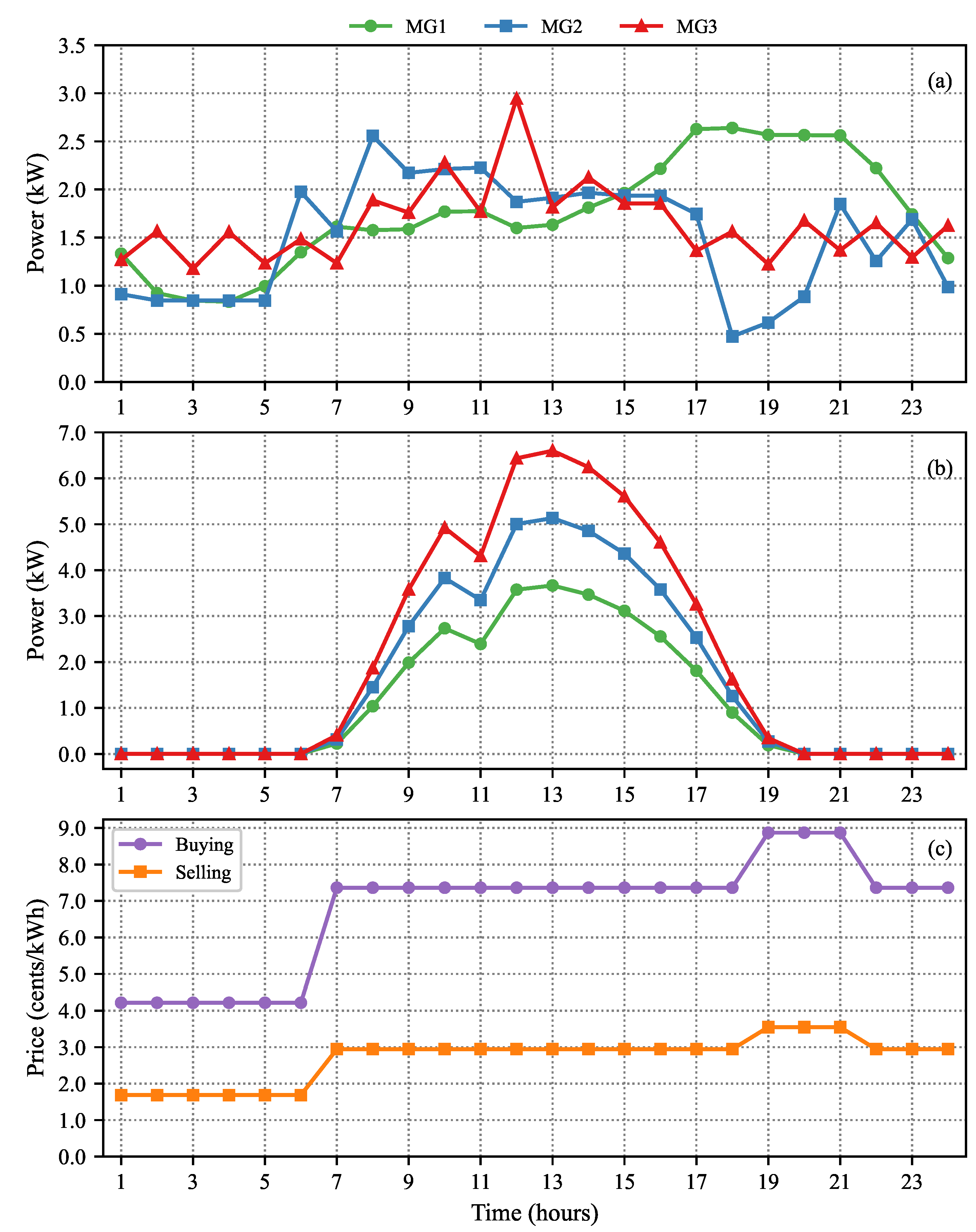
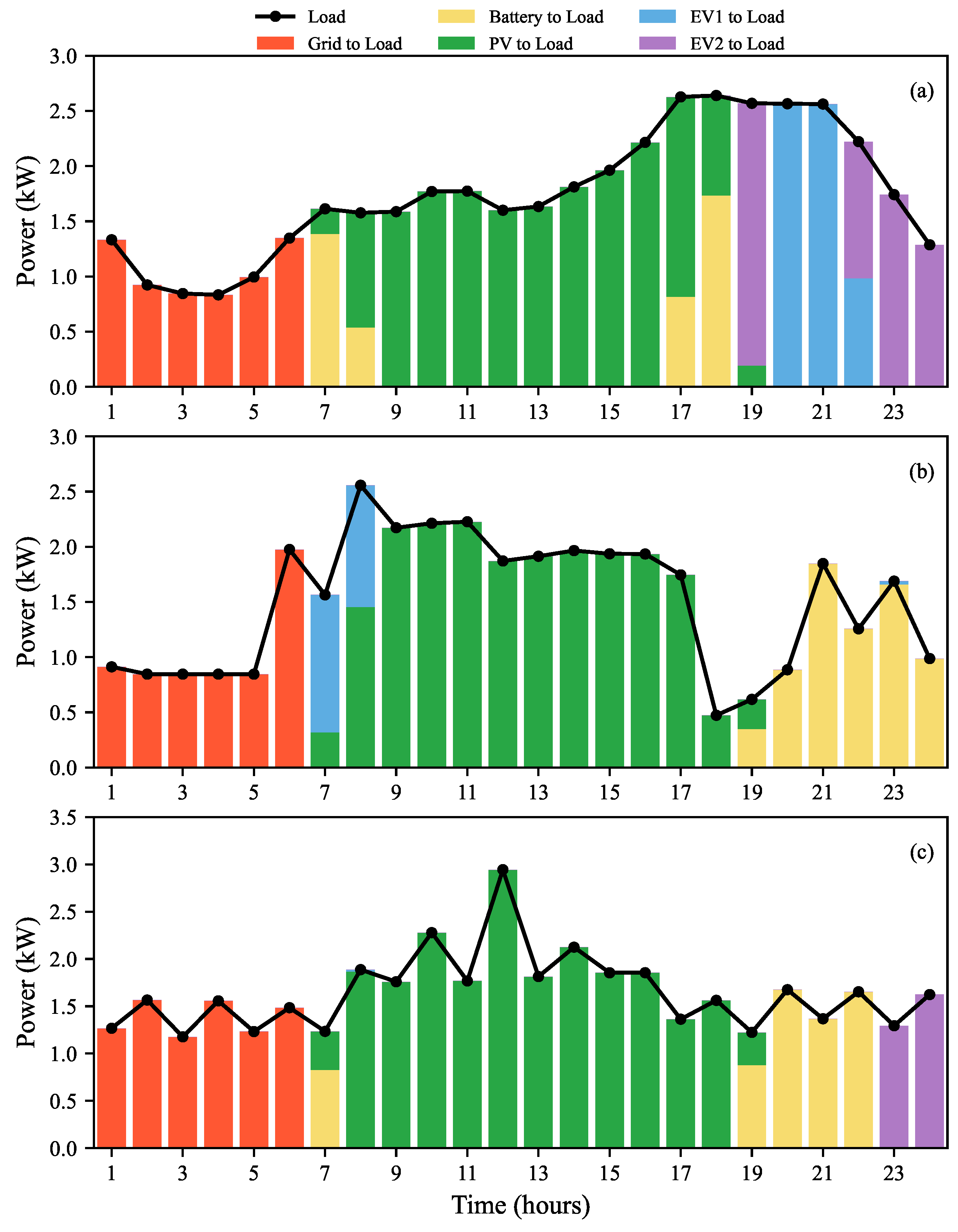



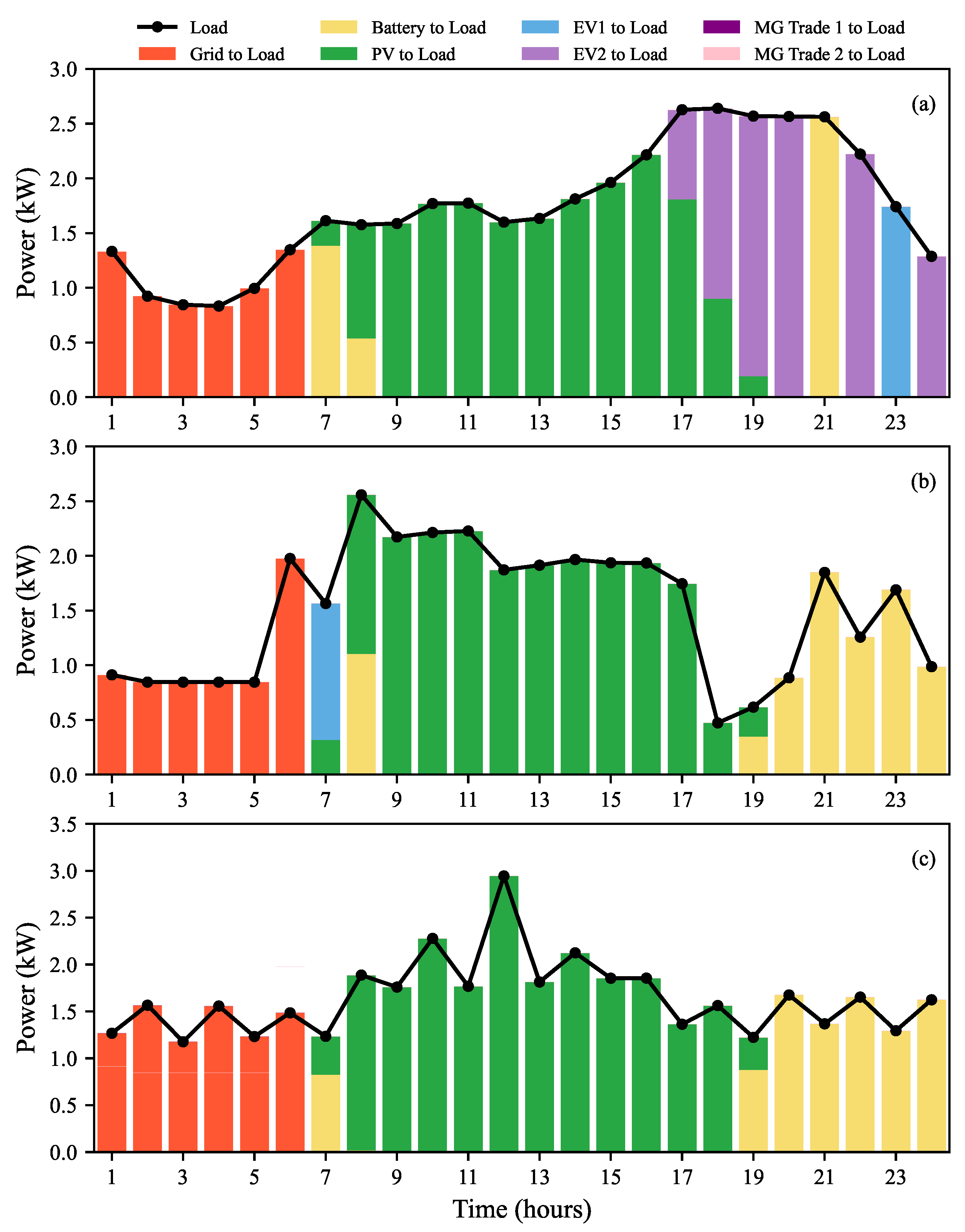
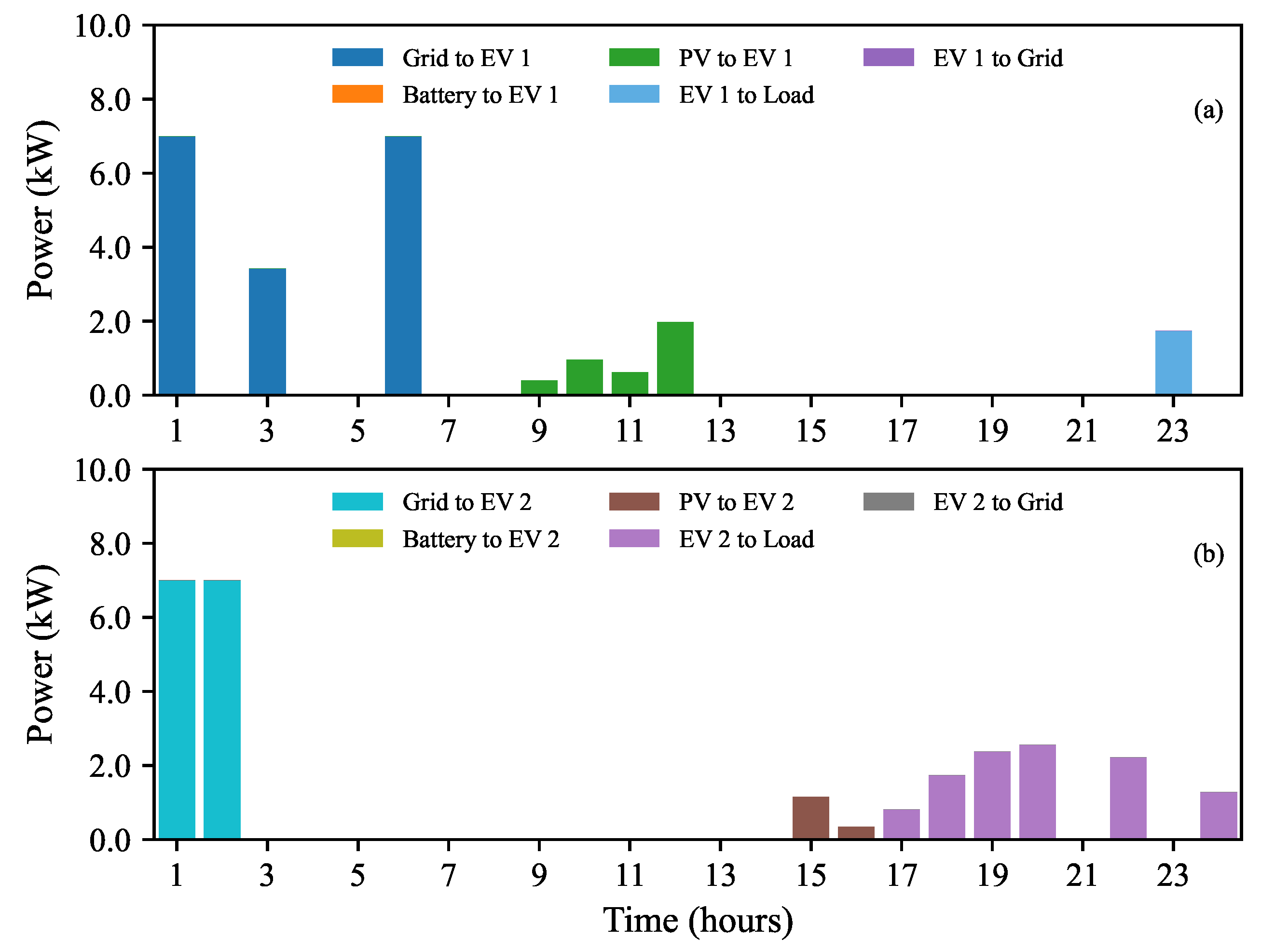
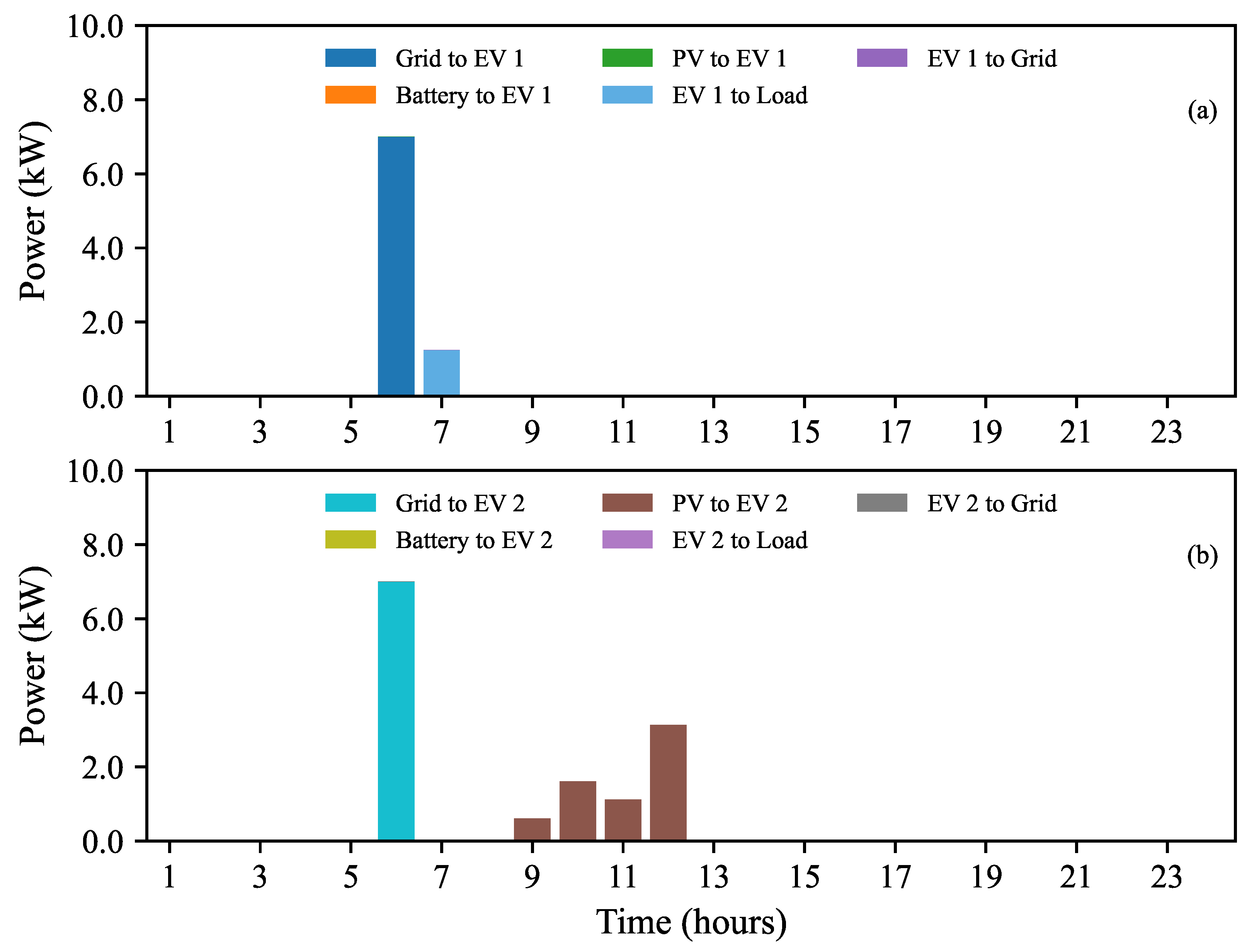

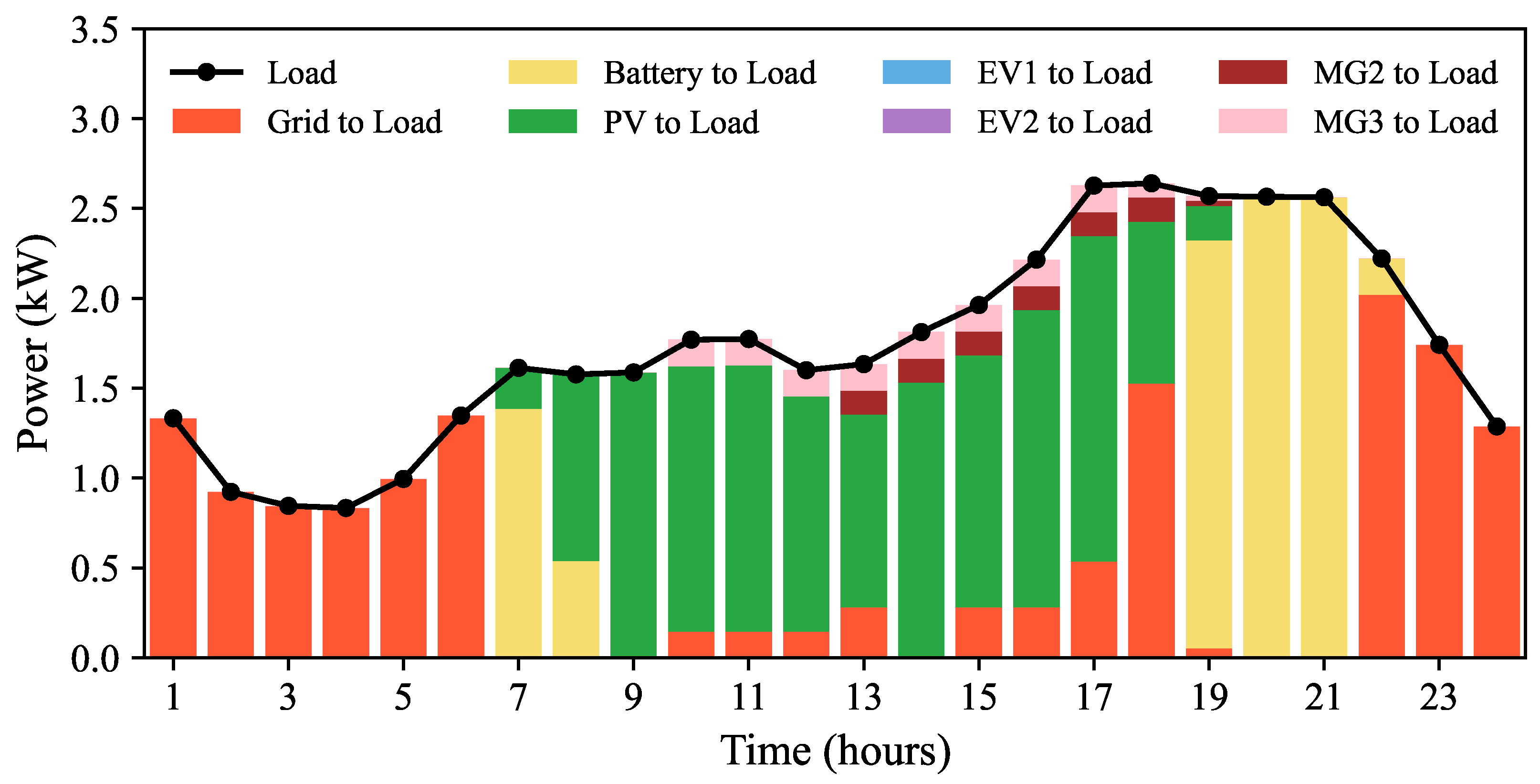

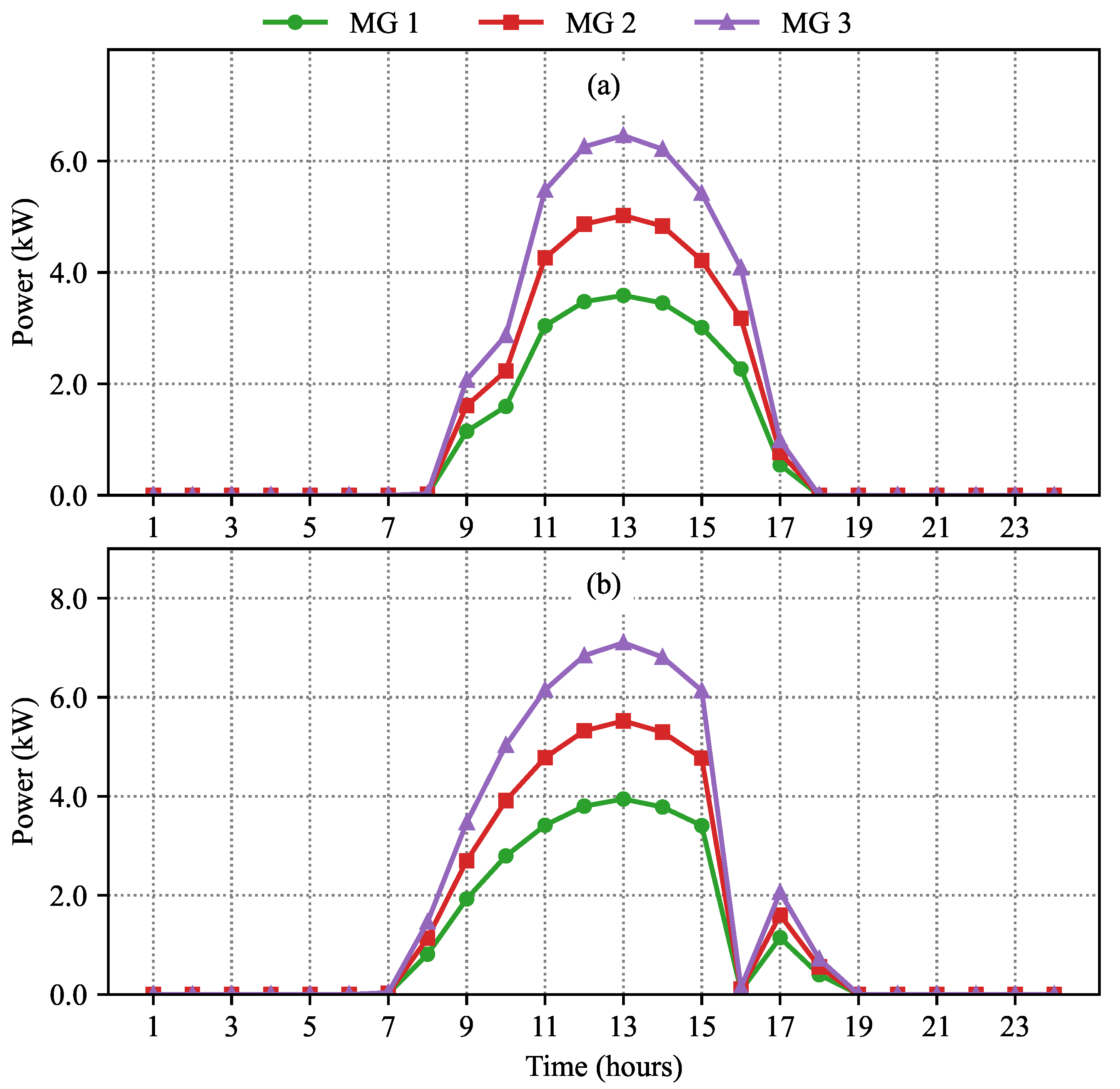
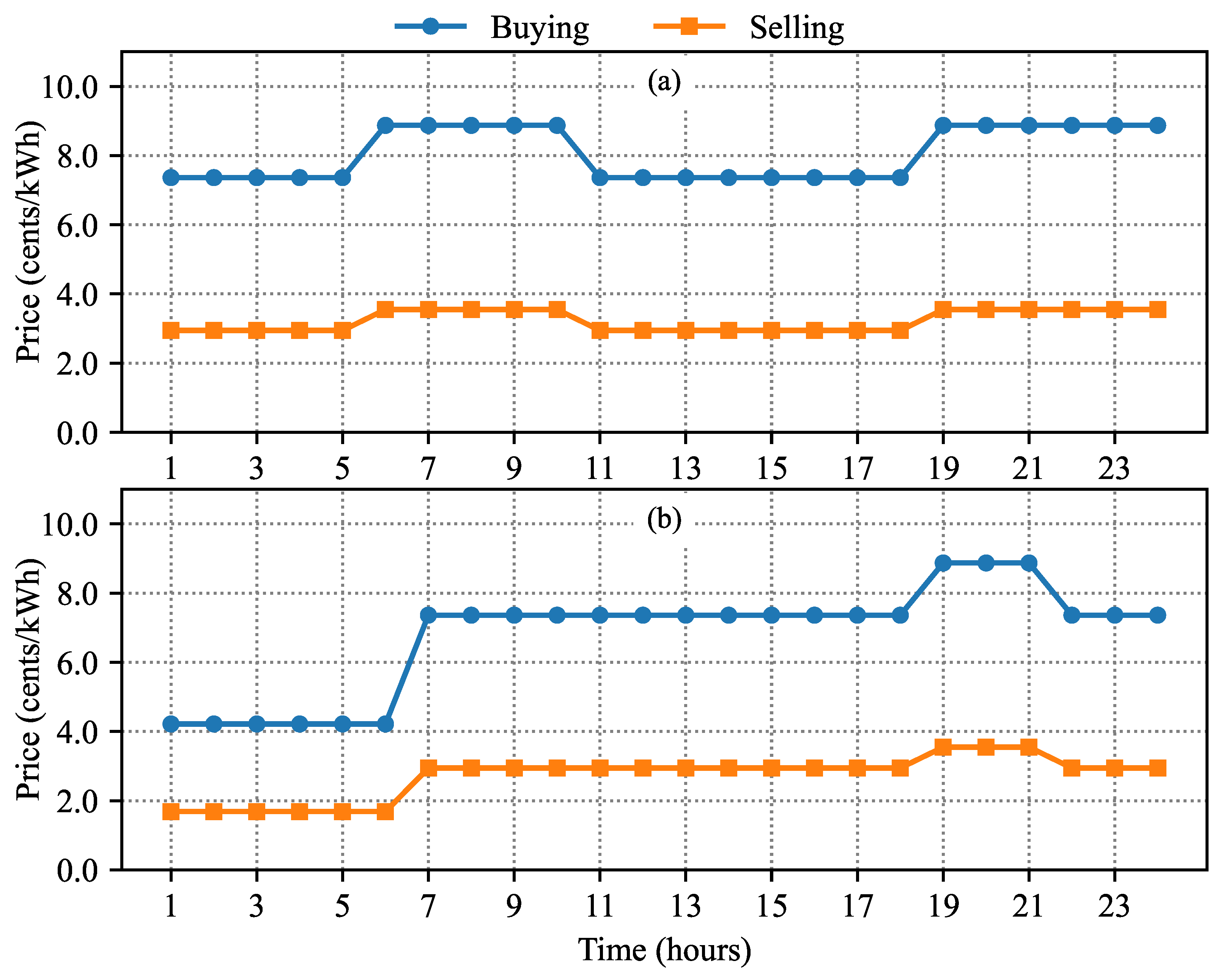
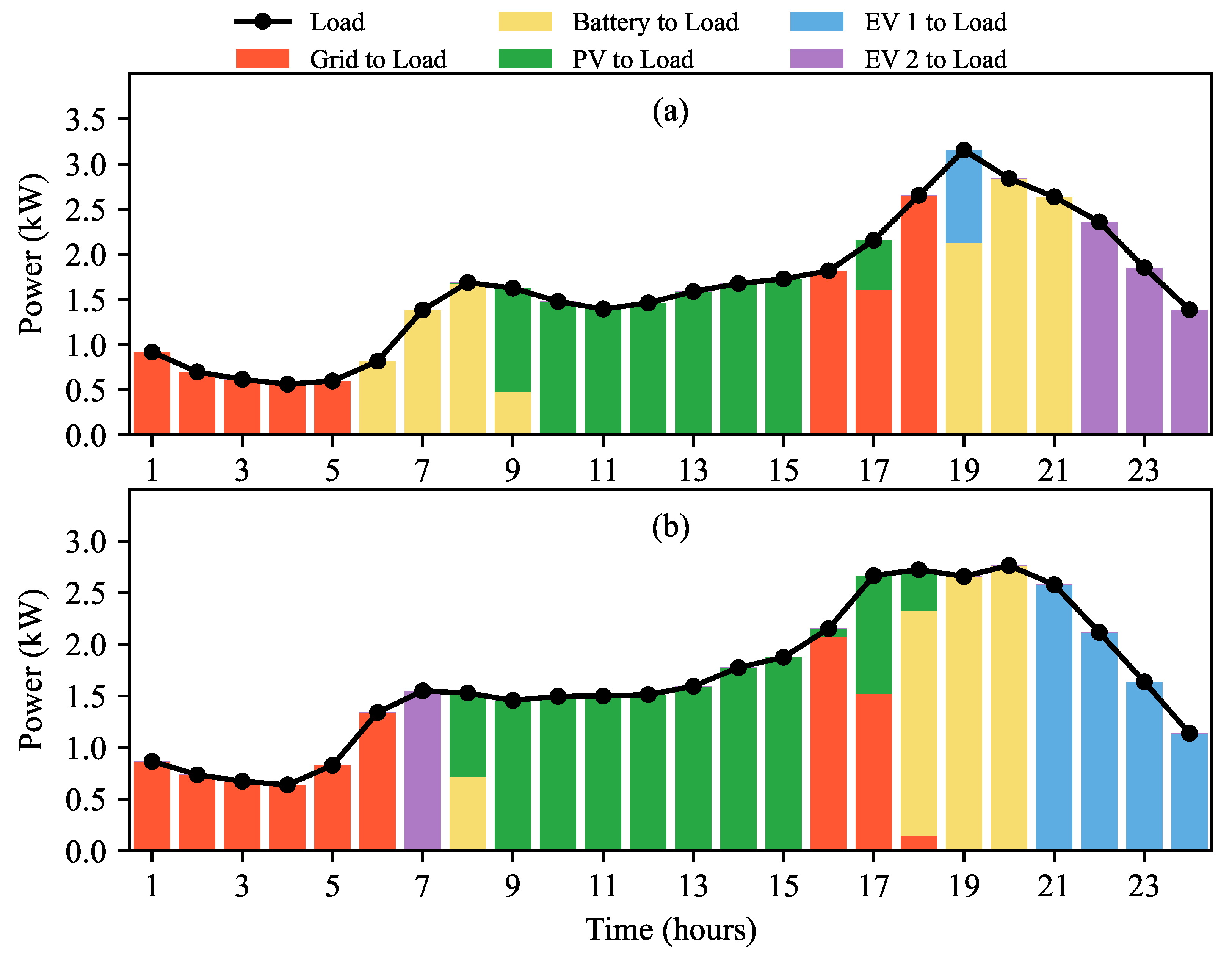
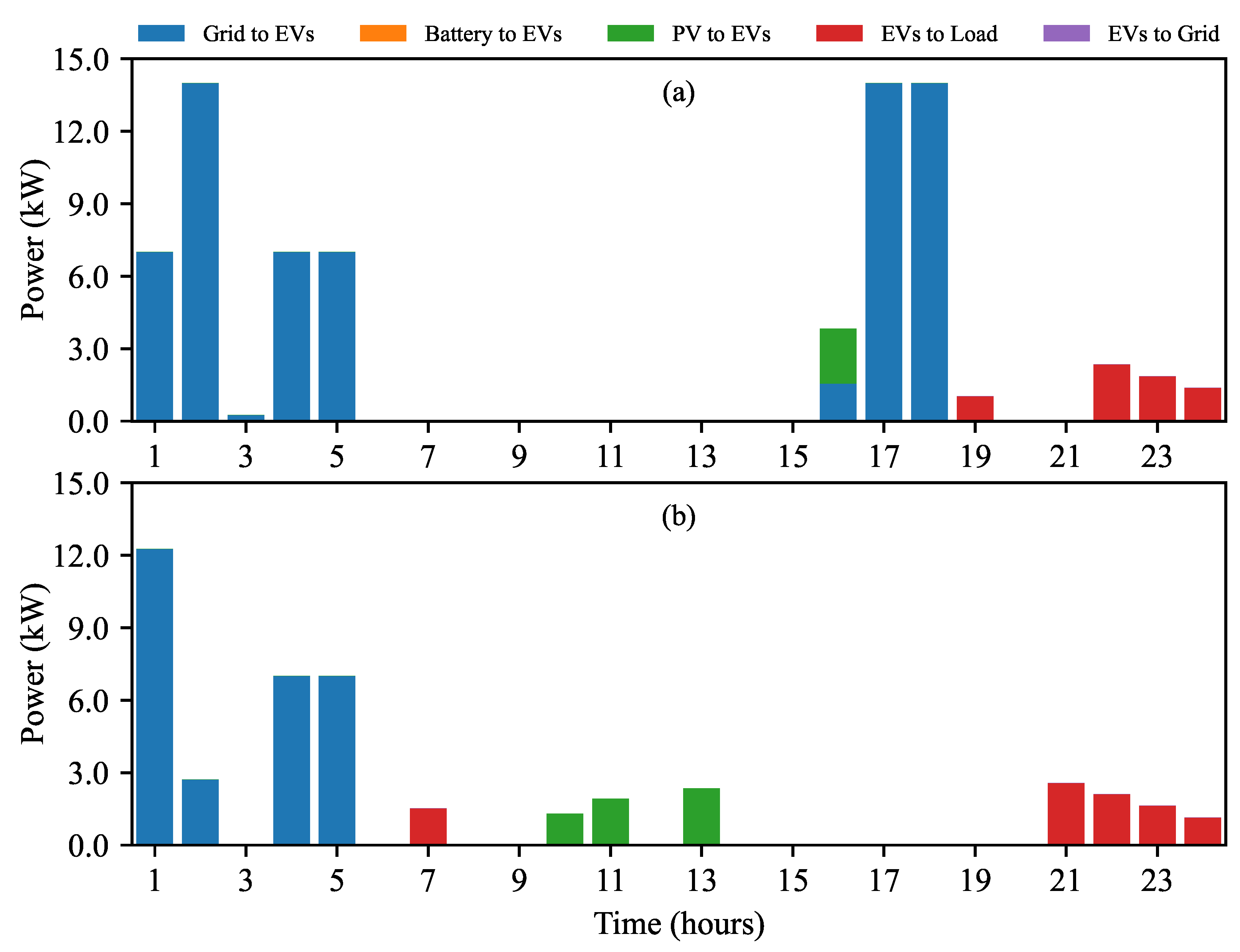
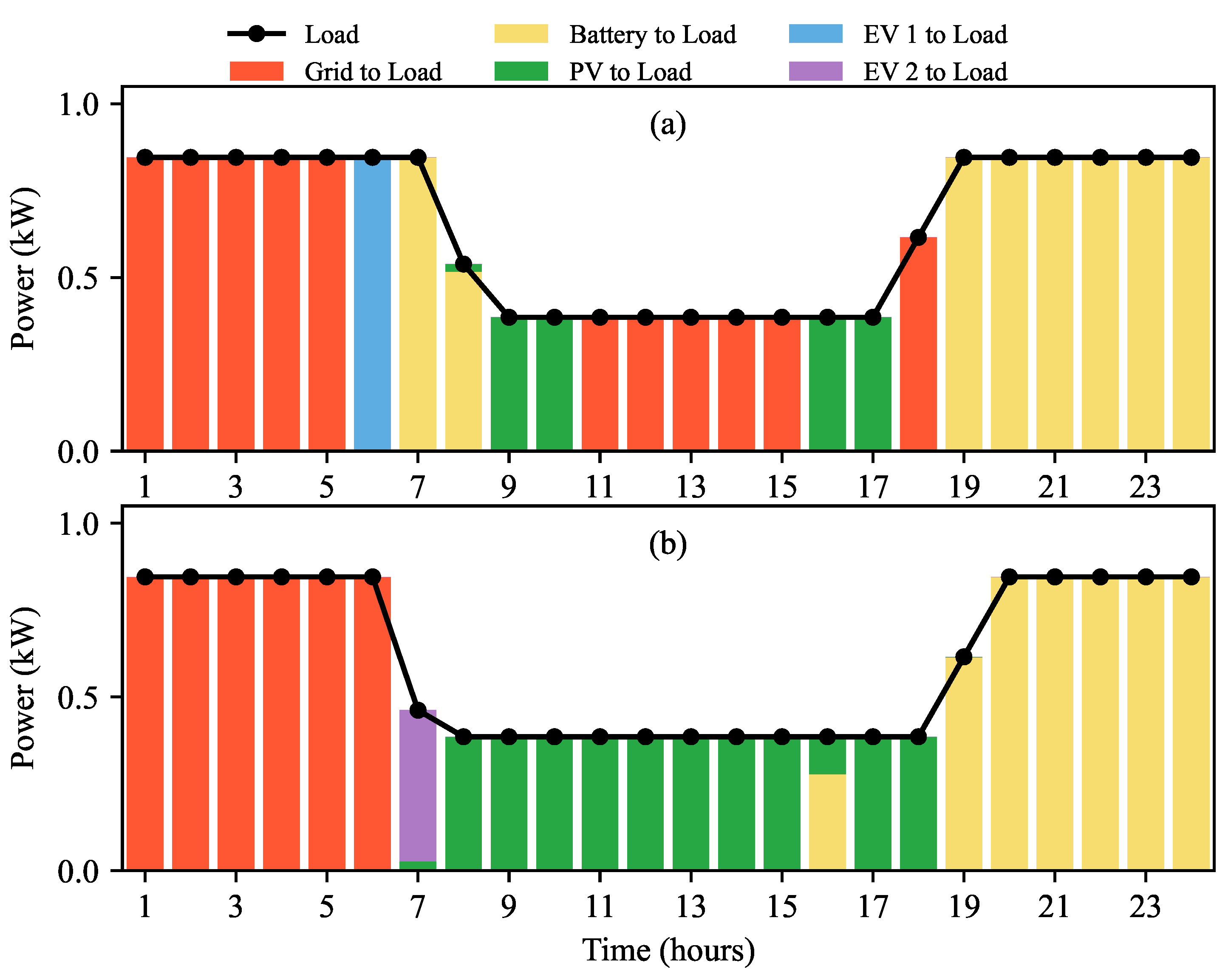
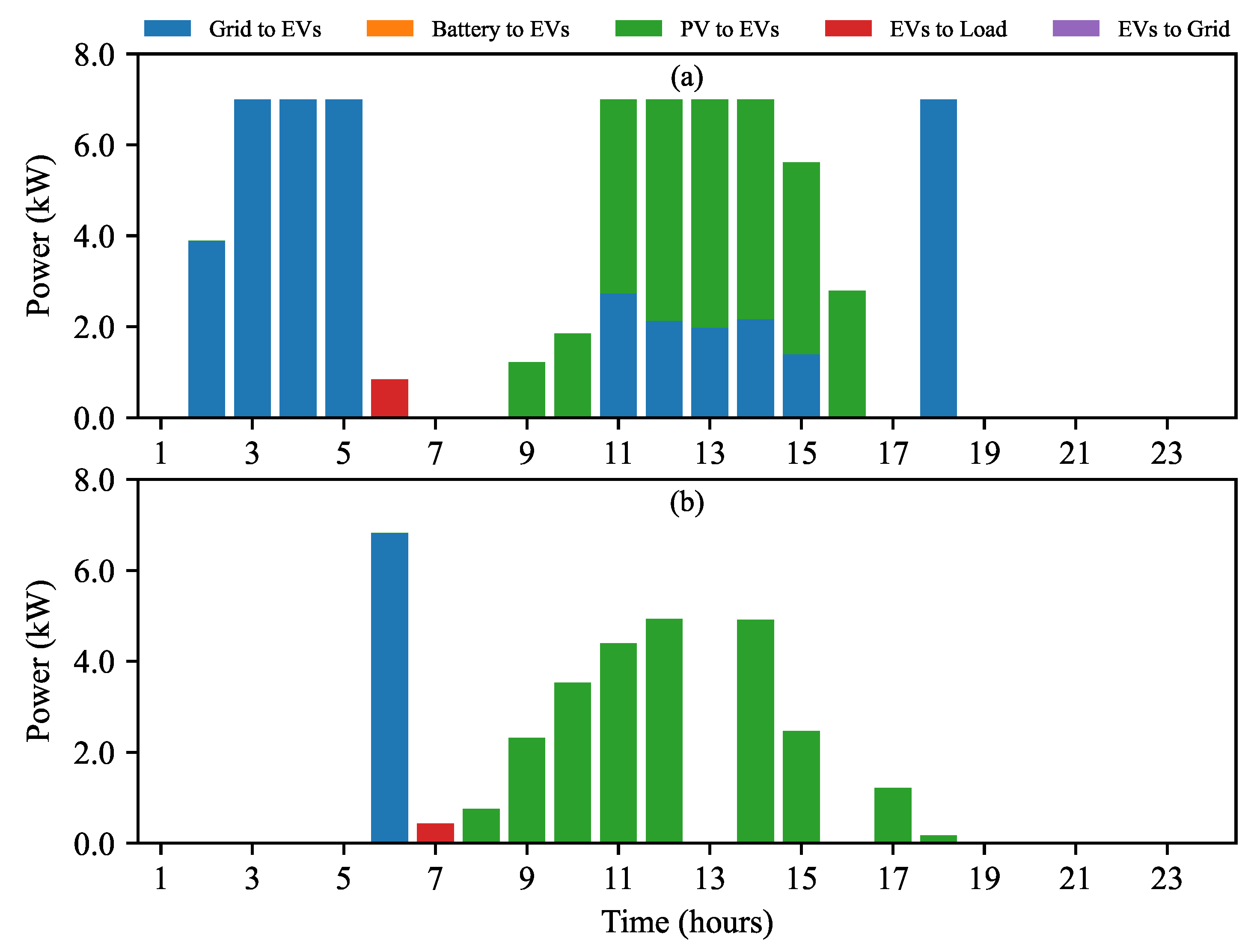


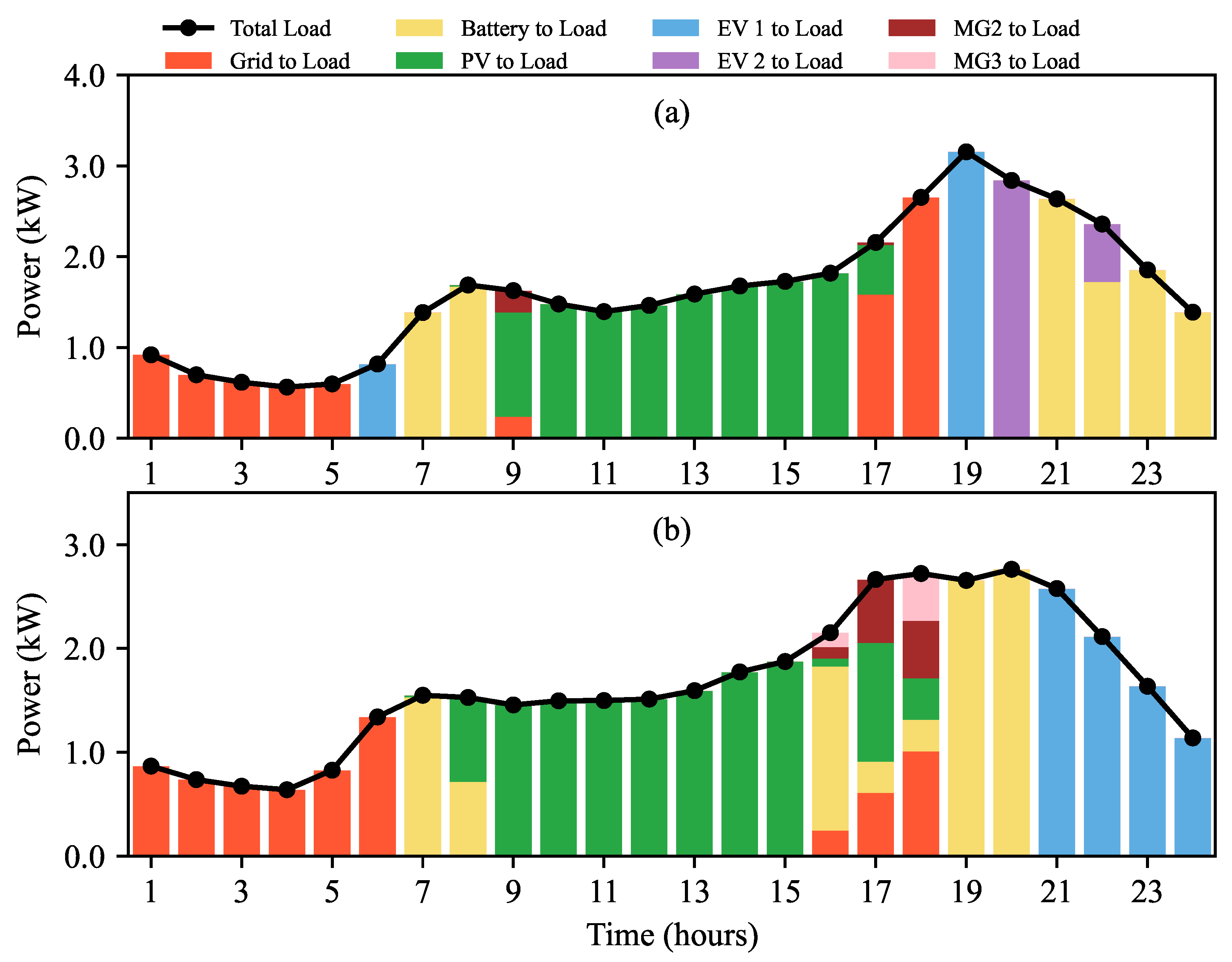


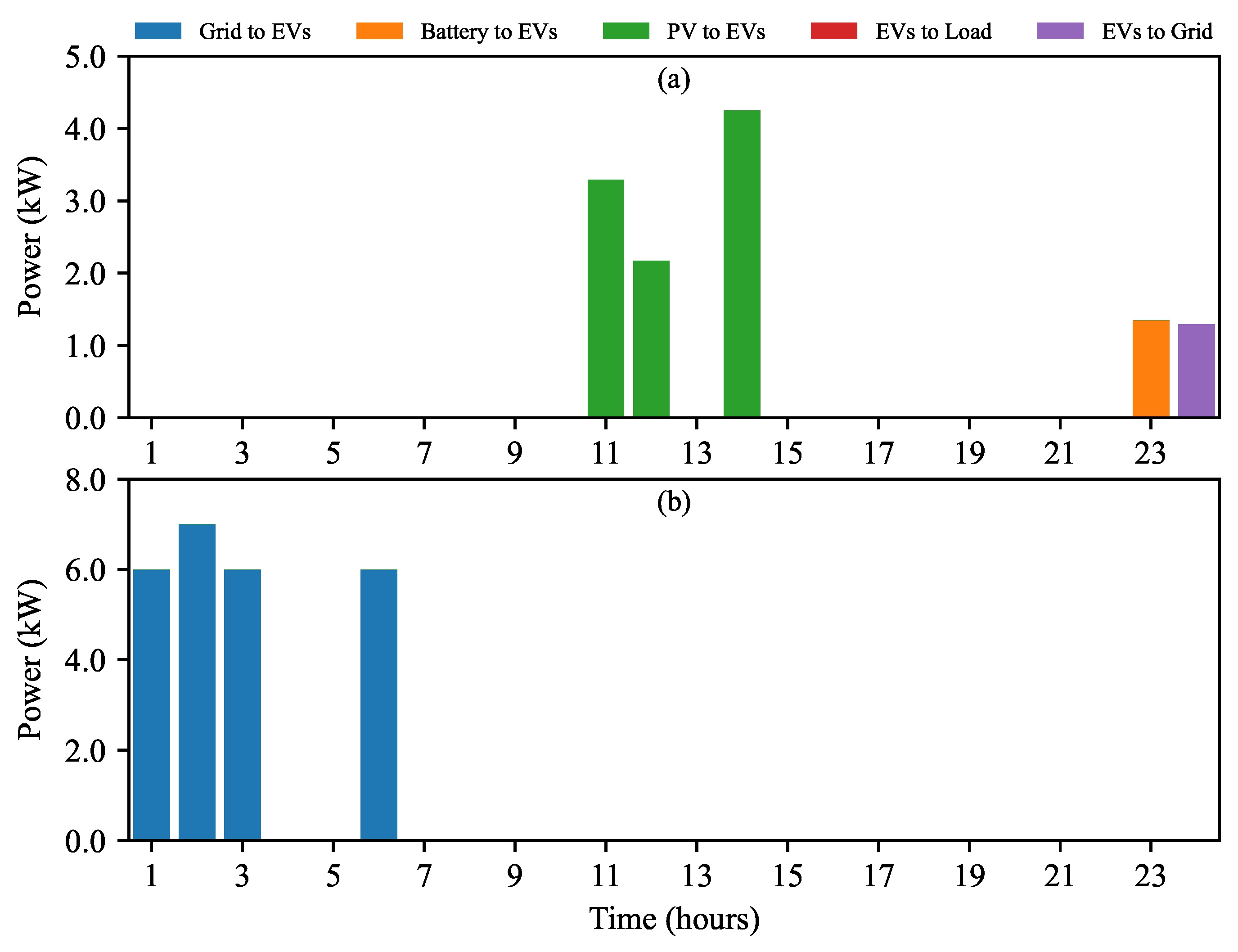
| Buying | Selling | Net (Buying − Selling) | |
|---|---|---|---|
| MG1 | 654.5 | 5.3 | 649.1 |
| MG2 | 574.9 | 7.5 | 567.4 |
| MG3 | 838.8 | 9.5 | 829.3 |
| Buying | Selling | Net (Buying − Selling) | |||||||
|---|---|---|---|---|---|---|---|---|---|
| Grid | MG1 | MG2 | MG3 | Grid | MG1 | MG2 | MG3 | ||
| MG1 | 608.3 | - | 1.50 | 1.7 | 5.4 | - | 0.7 | 1.7 | 603.7 |
| MG2 | 532.6 | 0.7 | - | 0.8 | 6.5 | 1.5 | - | 2.6 | 523.5 |
| MG3 | 782.9 | 1.7 | 2.6 | - | 8.5 | 1.7 | 0.8 | - | 776.2 |
| MG1 | MG2 | MG3 | |
|---|---|---|---|
| Base Case (No Solar/BESS, No Optimization) | 1056.8 | 1160.7 | 1677.8 |
| Individual Optimization | 649.1 | 567.4 | 829.3 |
| Community-Based Optimization | 603.7 | 523.5 | 776.2 |
| Cooperative GT | 562.2 | 516.8 | 824.4 |
| ADMM | 603.8 | 529.8 | 777.6 |
Disclaimer/Publisher’s Note: The statements, opinions and data contained in all publications are solely those of the individual author(s) and contributor(s) and not of MDPI and/or the editor(s). MDPI and/or the editor(s) disclaim responsibility for any injury to people or property resulting from any ideas, methods, instructions or products referred to in the content. |
© 2025 by the authors. Licensee MDPI, Basel, Switzerland. This article is an open access article distributed under the terms and conditions of the Creative Commons Attribution (CC BY) license (https://creativecommons.org/licenses/by/4.0/).
Share and Cite
Ahsan, S.M.; Musilek, P. Optimizing Multi-Microgrid Operations with Battery Energy Storage and Electric Vehicle Integration: A Comparative Analysis of Strategies. Batteries 2025, 11, 129. https://doi.org/10.3390/batteries11040129
Ahsan SM, Musilek P. Optimizing Multi-Microgrid Operations with Battery Energy Storage and Electric Vehicle Integration: A Comparative Analysis of Strategies. Batteries. 2025; 11(4):129. https://doi.org/10.3390/batteries11040129
Chicago/Turabian StyleAhsan, Syed Muhammad, and Petr Musilek. 2025. "Optimizing Multi-Microgrid Operations with Battery Energy Storage and Electric Vehicle Integration: A Comparative Analysis of Strategies" Batteries 11, no. 4: 129. https://doi.org/10.3390/batteries11040129
APA StyleAhsan, S. M., & Musilek, P. (2025). Optimizing Multi-Microgrid Operations with Battery Energy Storage and Electric Vehicle Integration: A Comparative Analysis of Strategies. Batteries, 11(4), 129. https://doi.org/10.3390/batteries11040129







